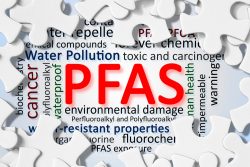 Recently, the Environmental Protection Agency (EPA) reported finding ‘forever chemicals’ in U.S. groundwater at concerning concentrations. These chemicals, also called PFAS compounds, are manmade synthetic substances present in various environments, ranging from soil and consumables to everyday household products and water. Exposure to these chemicals at high levels is linked to a wide variety of adverse health outcomes.
Recently, the Environmental Protection Agency (EPA) reported finding ‘forever chemicals’ in U.S. groundwater at concerning concentrations. These chemicals, also called PFAS compounds, are manmade synthetic substances present in various environments, ranging from soil and consumables to everyday household products and water. Exposure to these chemicals at high levels is linked to a wide variety of adverse health outcomes.
Research indicates that nearly all U.S. residents have encountered PFAS. Drinking water in the U.S. has shown high concentrations of these compounds. Unlike many industrial chemicals, PFAS do not degrade and are challenging to eliminate. Therefore their persistence in the environment raises significant concerns for human and animal health, and ultimately impacts our food and water supplies.
Almost 15,000 man-made substances are classified as forever chemicals. It has been reported that numerous drinking water locations across the nation have PFAS concentrations exceeding the EPA’s suggested thresholds of 4 and 10 parts per trillion. States on coastal areas are particularly noted for having the highest levels of contamination that surpass regulatory limits.
Treating PFAS in drinking water generates waste that must be carefully managed to prevent further environmental harm. Many managers of public water systems have expressed a need for additional information and guidance from the EPA on effective treatment techniques. Regulations are currently under development, and definitive solutions have not yet been established.
It’s crucial for individuals to be aware of their potential exposure to PFAS through tap water. Using water filters can mitigate some of the risks, and efforts are underway to regulate certain PFAS substances in American drinking water. While there’s no need for panic, people should be informed about what’s in their drinking water and understand the associated risks.
To view the original scientific study click below:
Persistent Chemicals: Additional EPA Actions Could Help Public Water Systems Address PFAS in Drinking Water





